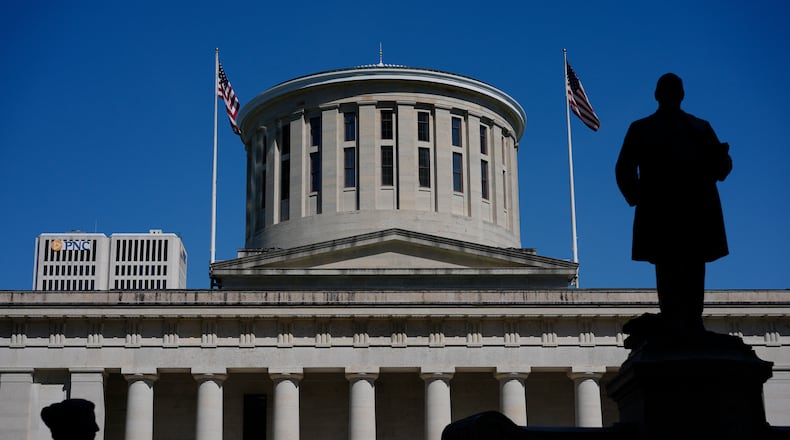The measure is in the GOP-authored draft budget that passed the Ohio House mostly along party lines and is now before the state Senate. It would require each public school district to charge less in property taxes for the next school year if the district’s carryover balance exceeds 30% of the district’s general fund expenditures.
This could impact 47 of the 57 school districts in Butler, Clark, Greene, Miami, Montgomery and Warren counties, according an analysis by this news outlet of data provided by the nonpartisan Legislative Service Commission — to a total of $553.7 million.
Dayton Public Schools, for example, ended fiscal year 2024 with nearly $139.2 million cash on hand, equivalent to roughly 58.2% of its budget, according to the LSC. The district would have to lower that amount by more than $67 million under the budget proposal.
Hiwot Abraha, Dayton Public Schools treasurer, said the district is deficit spending and using the cash carryover balance to cover expenses. Getting rid of the cash carryover balance could mean the district would need to be on the ballot more often, she said.
“I hope it doesn’t pass,” Abraha said. “It’s a lot of concern for our district and other districts.”
Lakota Local Schools would have to reduce its cash balance by $53.3 million; Springfield City Schools by $42.8 million.
Local districts with the largest carryover by percentage are New Lebanon Local Schools and Monroe Local Schools. Both have cash reserves worth more than 100% of their general fund.
TOP 10 AREA SCHOOLS IMPACTED
Below are the ten area districts with the largest difference between cash on hand now and what they would be allowed to have if the current state budget draft passes.
| County | District | General Fund Ending Cash Balance FY24 | Balance as as share of General Fund Expenditures FY24 | Estimated 30% of cash balance | Difference |
|---|---|---|---|---|---|
| Montgomery | Dayton Public Schools | $139,170,998 | 58.20% | $71,737,627.84 | $67,433,370.16 |
| Butler | Lakota Local Schools | $116,347,815 | 55.40% | $63,004,231.95 | $53,343,583.05 |
| Clark | Springfield City Schools | $77,859,674 | 66.60% | $35,071,925.23 | $42,787,748.77 |
| Montgomery | Huber Heights City Schools | $58,837,246 | 84.10% | $20,988,316.05 | $37,848,929.95 |
| Butler | Monroe Local Schools | $41,081,257 | 127.70% | $9,651,039.23 | $31,430,217.77 |
| Greene | Beavercreek City Schools | $52,926,400 | 52.50% | $30,243,657.14 | $22,682,742.86 |
| Butler | Hamilton City Schools | $53,111,209 | 49.90% | $31,930,586.57 | $21,180,622.43 |
| Warren | Mason City Schools | $60,212,926 | 44.00% | $41,054,267.73 | $19,158,658.27 |
| Greene | Fairborn City Schools | $34,493,712 | 59.90% | $17,275,648.75 | $17,218,063.25 |
| Greene | Xenia Community City Schools | $31,605,597 | 60.80% | $15,594,866.94 | $16,010,730.06 |
State officials explain
When the Ohio House’s budget draft was approved last week, Ohio House Finance Chair Brian Stewart, R-Ashville, said the carryover cap could provide up to $4.2 billion in reduced tax burden statewide. He said there’s over $10 billion sitting in school coffers across the state, with Ohio school districts on average sitting on a 45% year-over-year carryover.
Stewart and Ohio House Speaker Matt Huffman, R-Lima, have maintained that these balances have grown sharply over the past decade and even more quickly in recent years.
Ohio’s public schools are funded by a combination of state funding and local taxes, which typically come from property taxes. A small number of Ohio school districts collect income taxes.
Huffman told this outlet that large hike in property valuations in some counties caused schools to receive more property taxes, and the state put more into funding local schools over the past four fiscal years than previously.
“So, because of those two huge influxes of cash, and income taxes (going) up because of the $6 trillion (federal) stimulus and lots of other things, schools are just sitting on a lot more money than they can spend,” Huffman said.
School officials react
Huber Heights City Schools Superintendent Jason Enix said the district is keeping a close eye on the bill because the cash carryover balance is part of the district’s financial plan for the next five years.
The district is currently on the ballot requesting a $7.8 million tax levy increase. Huber Heights officials say the tax increase is needed because the district plans to spend down its reserves in future years.
Huber Heights has one of the largest cash carryover balances in the area at about 84% of the yearly budget. According to the state lawmakers’ calculations, the districts has about $37.8 million more than it needs.
But the district’s current financial trajectory puts that balance at about $14 million in 2029.
“Our five-year forecast shows deficit spending, and the implications to that cash balance to the long term is something that will be a detriment to this financial security,” Enix said.
Huber Heights schools faced fiscal problems in the early 2010s after several levies failed and the board then put policies in place that requires a cash balance equal to four months of operating expenses, or about $27 million in fiscal year 2025. This is still more than the state budget proposal would allow.
Shannon Cox, superintendent of the Montgomery County Educational Service Commission, said local schools are facing a variety of uncertain costs right now. For example, energy costs are expected to rise, but it’s not clear how much additional cost that could tack on for schools. Teachers may be retiring, so schools need to set money aside to deal with severance packages and hiring new teachers.
The proposal could also impact credit, Cox said. Having more money in the bank and being better able to pay bills allows for lower interest rates.
Cox said the process currently in place allows voters to not approve additional funds if residents think schools have too much money.
“If the community thinks that the school has too much money in their carryover, they’re not going to vote for the next levy,” she said.
School funding
Ohio’s public schools are required to publish a five-year forecast each May and November looking at the next five school years. Most schools carry over at least part of the annual budget from year to year. On average in Ohio, about 45.2% of the annual budget is carried over to the next year, according to the Ohio Legislative Service Commission.
School district reserves can ebb and flow. After a levy passes, they may put extra money aside to protect against inflation and spend it down in the later years of the levy’s life.
Within Montgomery County, there’s a wide variety of carryover balances — which districts call ending cash balance in the five-year forecasts — from about 24% at Kettering City Schools to 131% at New Lebanon Schools.
The difference in cash carryover depends on individual school districts and the policies put in place by school board members, said Cox.
“In my opinion, that needs to be decided at a local level, because different communities have different spending philosophies,” Cox said.
Huffman, meanwhile, hopes a carryover cap would facilitate a more direct conversation between school districts and their taxpayers.
“Look, there’s this disconnect (in) the discussion,” Huffman said. “The school looks on one side and says, ‘We need you to pass this levy and the reason is because these folks up here in the state won’t give us enough money.’ We’re going to say, ‘Hey, we’ll give you the money.’ Then we’ve got these people over here saying to us, ‘Why are our property taxes so high? Do something about it.’”
“Let’s have this discussion between the people who are spending the money and the people who are paying the money: The school district and the property tax payer,” Huffman continued. “That’s where the discussion needs to happen, not in a disjointed way from different groups.”


